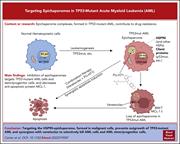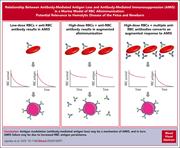Issue Archive
Table of Contents
BLOOD COMMENTARIES
PERSPECTIVE
Novel developments in the prophylaxis and treatment of acute GVHD
Acute graft-versus-host disease (GVHD) remains a major barrier to favorable outcomes with allogeneic stem cell transplantation. Jamy and colleagues review the emerging new strategies for prevention and treatment, outline key lessons about end points from recent trials, and provide their perspectives on where the field needs to head. This Perspective informs current practice and points toward a future where acute GVHD is less prominent.
LYMPHOID NEOPLASIA
Real-world experience of CAR T-cell therapy in older patients with relapsed/refractory diffuse large B-cell lymphoma
CME
Clinical Trials & Observations
Almost one-half of patients diagnosed with diffuse large B-cell lymphoma are at least 65 years old, and historically their prognosis has been poor after failure of first-line therapy. CD19-directed autologous chimeric antigen receptor (CAR) T-cell therapy has changed outcomes for younger patients. In this month’s CME article, Chihara and colleagues analyzed real-world data for CAR T-cell therapy in older patients from the United States. They report encouraging long-term efficacy but low uptake for patients aged 65 to 75 years and very low utilization for those >75 years of age.
MYELOID NEOPLASIA
Epichaperome inhibition targets TP53-mutant AML and AML stem/progenitor cells
Epichaperome complexes, comprising heat shock protein 90 (HSP90) and associated proteins, act to maintain malignant phenotypes and are enriched in acute myeloid leukemia (AML) stem cells. After identifying HSP90 inhibitors as top hits in a high-throughput drug screen, Carter et al found that targeting the epichaperome with the HSP90 inhibitor PU-H71 boosts the effectiveness of venetoclax in treating AML, inhibiting the outgrowth of venetoclax-resistant TP53-mutant AML in vivo in murine models. These data support clinical investigation of PU-H71 with venetoclax in patients with TP53-mutant AML, where prognosis has remained dismal despite the introduction of targeted therapies.
THROMBOSIS AND HEMOSTASIS
Safety and efficacy of an anti–human APC antibody for prophylaxis of congenital factor deficiencies in preclinical models
Activated protein C (APC) inhibits both thrombin generation and inflammation. Jiang et al describe the development and characterization of an engineered humanized monoclonal antibody (SR604) designed to target the APC protease domain, which is critical for anticoagulant activity but dispensable for anti-inflammatory signaling, thereby reducing the risk of promoting thrombosis. In vivo, SR604 limits bleeding in hemophilic mice to a similar extent to recombinant factor VIII, suggesting that it warrants clinical investigation for restoration of hemostasis in patients with hemophilia and other rare bleeding disorders.
TRANSFUSION MEDICINE
Antibody-mediated antigen loss switches augmented immunity to antibody-mediated immunosuppression
Anti-RhD immunoprophylaxis works because of antibody-mediated immunosuppression (AMIS), but the mechanisms governing AMIS are poorly understood. Using an established murine model of red blood cell (RBC) alloimmunization, Jajosky et al demonstrate that passive immunization with RBC antibodies can remove target antigens from RBCs without affecting RBC clearance or CD4+ T-cell proliferation, thereby converting an augmented RBC alloimmune response to AMIS. These data have implications for how immunoprophylaxis is approached for non-RhD hemolytic disease of the fetus and newborn.
LETTER TO BLOOD
Platelet count threshold for hemorrhage in patients with immune thrombocytopenia treated with antiplatelet agents
Clinical Trials & Observations
A significant proportion of older patients with immune thrombocytopenia (ITP) also have clinical indications for treatment of cardiovascular disease with antiplatelet agents. Ollier and colleagues sought to determine the frequency of bleeding in patients with ITP on aspirin therapy, finding that the pattern of bleeding, segregated by platelet count, is similar to that observed in other adults with ITP not on aspirin. They show that a platelet count of <20 × 109/L is associated with most bleeding in ITP patients on antiplatelet agents.
BLOOD WORK
ERRATA
CONTINUING MEDICAL EDUCATION (CME) QUESTIONS
-
Cover Image
Cover Image
![issue cover]()
A confocal microscopy image of immunofluorescent staining with a pan–inflammatory cell marker (CD45, green) shows lipopolysaccharide-induced inflammatory cell infiltration in a lung tissue section from a PROC+/+;F9−/− mouse. Blue indicates cell nuclear staining. See the article by Jiang et al on page 1071.
- PDF Icon Front MatterFront Matter
- PDF Icon Table of ContentsTable of Contents
- PDF Icon Back MatterBack Matter
- PDF Icon Editorial BoardEditorial Board
Advertisement intended for health care professionals
Email alerts
Advertisement intended for health care professionals







CARs put age in the rearview mirror